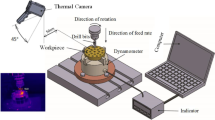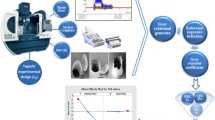Abstract
In this present study, the effect of drilling parameters and carbide drill bits in drilling of Al 5083 H116 alloy was investigated. The drilling tests were carried out using various carbide drill bits at 40, 80, 120, 160 m/min cutting speeds and 0.025, 0.050, 0.075, 0.100 feed rates. The experimental design was performed using the Taguchi’s L16 orthogonal array. The drilling tests were carried out without using coolant and it was aimed to minimize the thrust force, drill bit temperature and burr formation at the hole exit. Simultaneous optimization was performed using Taguchi-based Grey Relational Analysis (GRA). Using the data obtained from the drilling tests, mathematical models with Response Surface Methodology (RSM) and predicted values with Artificial Neural Networks (ANN) were obtained. It was observed that there was a significant increase in thrust force and burr height with increasing feed rate. In addition, the drill bit temperature was adversely affected by the increasing values of the cutting speed. The most effective control factors according to the analysis of variance were found to be the feed rate with 99.9 % for thrust force, cutting speed with 91.54 % for drill bit temperature and feed rate with 79.78 % for burr height. As a result of GRA, the feed rate with a value of 0.3612 was determined as the most important control factor, moreover, according to RSM results, the optimum parameters were 40 m/min cutting speed, 0.025 mm/rev feed rate and drill bit 1. The reliability of the developed mathematical model was confirmed with determination coefficients of 99.1 % for the thrust force, 98.8 % for the drill bit temperature and 99.7 % for the burr height. With ANN, a prediction success rate of 99.8 % for thrust force, 99.8 % for drill bit temperature and 99.6 % for burr height was achieved.














Similar content being viewed by others
References
Songmene V, Khettabi R, Zaghbani I, Kouam J, Djebara A (2011) Machining and machinability of aluminum alloys. INTECH Open Access Publisher. https://doi.org/10.5772/14888
Rotella G, Dillon OW, Umbrello D, Settineri L, Jawahir IS (2013) Finite element modeling of microstructural changes in turning of AA7075-T651 alloy. J Manuf Process 15(1):87–95. https://doi.org/10.1016/j.jmapro.2012.09.005
Paturi UMR, Narala SKR, Pundir R (2014) Constitutive flow stress formulation, model validation and FE cutting simulation for AA7075-T6 aluminum alloy. Mater Sci Eng: A 605:176–185. https://doi.org/10.1016/j.msea.2014.03.033
Çaydaş U (2017) Investigaton of the effects of cutting parameters on the surface roughness, tool temperature and thrust force in drilling of AA 7075-T6 alloy. J Polytech 20(29):419–425. https://doi.org/10.2339/2017.20.2
Kalpakjian S, Schmid S (2014) Manufacturing engineering and technology, 7th edn. Pearson Education Inc, Singapore, pp 625–665
Das R, Barik T (2014) An experimental study on the burr formation in drilling of aluminum channels of rectangular section”, 5th International & 26th All India Manufacturing Technology, Design and Research Conference (AIMTDR), pp 831–85
Kurt M, Kaynak Y, Bakır B, Köklü U, Atakök G, Kutlu L (2009) Experimental investigation and Taguchi optimization for the effect of cutting parameters on the drilling of Al 2024-t4 alloy with diamond like carbon (DLC) coated drills, 5. Uluslararası İleri Teknolojiler Sempozyumu (IATS’09), Karabük, Türkiye
Tonshoff HL, Spintig W, Konig W, Neises A (1994) Machining of holes developments in drilling techonolgy. Ann CIRP 43(2):551–560. https://doi.org/10.1016/S0007-8506(07)60501-0
Çakır A, Bahtiyar O, Şeker U (2014) Farklı soğutma şartları ile farklı kesme parametrelerinin AA7075 ve AA2024 alüminyum alaşımlarında delik delme işlemlerine etkisinin deneysel olarak incelenmesi, 16. Uluslararası Makina Tasarım ve İmalat Kongresi, 30 Haziran – 03 Temmuz 2014, İzmir, Türkiye
Gökçe H (2020) Investigation of drilling performance of copper material in terms of cutting force and tool temperature. El-Cezerî J Sci Eng 7(3):1039–1053. https://doi.org/10.31202/ecjse.730812
Yağmur S, Acır A, Şeker U, Günay M (2013) An experimental investigation of effect of cutting parameters on cutting zone temperature in drilling. J Fac Eng Archit Gazi Univ 28(1):1–6
Colligan K (1994) New tool drills both titanium and carbon composites. Am Mach 138(10):56–58
Kim D, Ramulu M (2205) Cutting and drilling characteristics of hybrid titanium composite laminate (HTCL). In: Proceedings of Materials and Processing Technologies for Revolutionary Applications Fall Technical Conference, Seattle, Washington, 1–8
Lambert BK (1979) Prediction of force, torque and burr length in drilling titanium-composite materials. SME Technical Paper MR 79–363
Çiftçi İ, Gökçe H (2019) Optimisation of cutting tool and cutting parameters in machining of molybdenum alloys through the Taguchi Method. J Fac Eng Archit Gazi Univ 34(1):201–213. https://doi.org/10.17341/gazimmfd.416482
Yavuz M, Gökçe H, Çiftçi İ, Gökçe H, Yavaş Ç, Şeker U (2020) Investigation of the effects of drill geometry on drilling performance and hole quality. Int J Adv Manuf Technol 106(9):4623–4633. https://doi.org/10.1007/s00170-019-04843-3
Gökçe H, Çiftçi İ, Demir H (2018) Cutting parameter optimization in shoulder milling of commercially pure molybdenum. J Braz Soc Mech Sci Eng 40:360. https://doi.org/10.1007/s40430-018-1280-8
Bayraktar Ş, Siyambaş Y, Turgut Y (2017) Delik delme prosesi: bir araştırma. Sakarya Üniversitesi Fen Bilimleri Enstitüsü Dergisi 21(2):120–130. https://doi.org/10.16984/saufenbilder.296833
Meral G, Dilipak H, Sarıkaya M (2011) AISI 1050 malzemenin delinmesinde delme parametrelerinin delik kalitesi üzerindeki etkisinin çoklu regresyon metoduyla modellenmesi. Makine Teknolojileri Elektronik Dergisi 8(1):37–46
Dhar NR, Ahmed NT, Islam S (2007) An experimental investigation on effect of minumum quantity lubrication in machining AISI 1040 steel. Int J Mach Tools Manuf 47:748–753. https://doi.org/10.1016/j.ijmachtools.2006.09.017
Bayraktar Ş, Turgut Y (2016) AL-5083 alaşımının frezelenmesinde kesme kuvveti, yüzey pürüzlülüğü ve çapak yüksekliğinin optimizasyonu. 7th International Symposium on Machining, November 3–5, Marmara University, İstanbul
Kakati AK, Chandrasekaran M, Mandal A, Singh AK (2011) Prediction of optimum cutting parameters to obtain desired surface in finish pass end milling of aluminium alloy with carbide tool using artificial neural network. World Acad Sci Eng Technol 5(9):1929–1935. https://doi.org/10.5281/zenodo.1063264
Dörterler M, Şahin İ, Gökçe H (2019) A grey wolf optimizer approach for optimal weight design problem of the spur gear. Eng Optim 51(6):1013–1027. https://doi.org/10.1080/0305215X.2018.1509963
Devitte C, Souza GSC, Souza AJ, Tita S, Tita V (2021) Optimization for drilling process of metal-composite aeronautical structures. De Gruyter. https://doi.org/10.1515/secm-2021-0027
Yaşar N, Boy M, Günay M (2017) The effect of drilling parameters for surface roughness in drilling of AA7075 alloy. 21st Innovative Manufacturing Engineering & Energy International Conference-IManE&E 2017, 8. https://doi.org/10.1051/matecconf/201711201018
Rubi CS, Prakash JU, Rajkumar C (2020) Optimization of process parameters using taguchi technique for drilling aluminium matrix composites (LM6/B4C). IOP Conference Series: Materials Science and Engineering, 912, 032016. https://doi.org/10.1088/1757-899X/912/3/032016
Ghosh T, Wang Y, Martinsen K, Wang K (2020) A surrogate-assisted optimization approach for multi-response end milling of aluminum alloy AA3105. Int J Adv Manuf Technol 111:2419–2439. https://doi.org/10.1007/s00170-020-06209-6
Dave S, Vora JJ, Thakkar N, Singh A, Srivastava S, Gadhvi B, Patel VV, Kumar A (2016) Optimization of EDM drilling parameters for aluminum 2024 alloy using response surface methodology and genetic algorithm. Key Eng Mater 706:3–8. https://doi.org/10.4028/www.scientific.net/KEM.706.3
Golshan A, Ghodsiyeh D, Gohari S, Ayob A, Baharudin BTHT (2012) Optimization of machining parameters during drilling of 7075 aluminium alloy. Appl Mech Mater 248:20–25. https://doi.org/10.4028/www.scientific.net/AMM.248.20
Haleel AJ (2018) Optimization drilling parameters of aluminum alloy based on taguchi method. Al-Khwarizmi Eng J 14(2):14–21. https://doi.org/10.22153/kej.2018.12.001
Kundu S, Das S, Saha PP (2014) Optimization of drilling parameters to minimize burr by providing back-up support on aluminium alloy. Procedia Eng 97:230–240. https://doi.org/10.1016/j.proeng.2014.12.246
http://www.matweb.com/search/DataSheet.aspx?MatGUID=1efe7441a72f4a22a53c0dc1bd9cc1bd9c87ec&ckck=1. Accessed: 10.01.2021
Gökçe H, Yavuz M, Karayel M (2017) Dynamometer design and manufacturing for cutting force definition on machining process. Gazi J Eng Sci 3(2):27–32
Kökçam AH, Uygun Ö, Kılıçaslan E (2018) Optimum tire selection with grey relational analysis. J Intell Syst Theory Appl 1(1):31–35. https://doi.org/10.38016/jista.452996
Kuo Y, Yang T, Huang GW (2008) The use of grey relational analysis in solving multiple attribute decisionmaking problems. Comput Ind Eng 55(1):80–93. https://doi.org/10.1016/j.cie.2007.12.002
Peker İ, Baki B (2011) Gri ilişkisel analiz yöntemiyle türk sigortacılık sektöründe performans ölçümü. Int J Econ Admin Stud 4(7):1307–9832
Köse W, Temiz İ, Erol S (2011) Grey system approach for economic order quantity models under uncertainty. J Grey Syst 23(1):71–82
Günay M, Meral T (2020) Modelling and multiresponse optimization for minimizing burr height, thrust force and surface roughness in drilling of ferritic stainless steel. Indian Acad Sci – Sådhanå 45:275. https://doi.org/10.1007/s12046-020-01490-3
Yaşar N (2019) Thrust force modelling and surface roughness optimization in drilling of AA-7075: FEM and GRA. J Mech Sci Technol 33:4771–4781. https://doi.org/10.1007/s12206-019-0918-5
Mavi A (2018) Gri ilişkisel analiz yöntemi ile dubleks paslanmaz çeliklerin delinmesinde yüzey form özelliklerini etkileyen optimum kesme parametrelerinin belirlenmesi. Gazi Üniv Fen Bilimleri Dergisi Part C: Tasarım ve Teknoloji. 6:634–643. https://doi.org/10.29109/gujsc.395667
Ekici E, Motorcu AR, Uzun G (2017) An investigation of the effects of cutting parameters and graphite reinforcement on quality characteristics during the drilling of Al/10B4C composites. Measurement 95:395–404. https://doi.org/10.1016/j.measurement.2016.10.041
Uzun G, Gökmen U, Çinici H, Türker M (2017) Effect of cutting parameters on the drilling of AISI7 metallic foams. Mater Technol 51(1):19–24. https://doi.org/10.17222/mit.2015.106
Uzun H, Meral T, Günay M (2020) Modelling and optimization of burr height in fiber laser drilling of ferritic stainless steel. Manuf Technol Appl 1(2):32–39
Agapiou JS, DeVries MF (1990) On the determination of thermal phenomena during drilling-Part I-Analytical models of twist drill temperature distributions. Int J Mach Tools Manuf 30:203–215. https://doi.org/10.1016/0890-6955(90)90130-B
Gökçe H (2019) Optimization of cutting tool and cutting parameters in face milling of Custom 450 through the Taguchi method. Adv Mater Sci Eng 1–11. https://doi.org/10.1155/2019/5868132
Haung HT, Weng C, Chen CK (1994) Analysis of clearance and rake angles along cutting edge for Multifacet Drills (MFD). J Eng For Ind 116(8):8–16
Uçak N, Çiçek A (2019) Investigation of the effects of cryogenic cooling on drilling performance in drilling of Inconel 718 superalloy. J Fac Eng Archit Gazi Univ 34(3):1241–1252. https://doi.org/10.17341/gazimmfd.460519
Çakıroğlu R, Acır A (2013) Taguchi optimization method of tool chip interface temperature depending on the cutting parameters in drilling operations. Electron J Mach Technol 10(2):73–86
İsmail TEKAÜT, Halil DEMİR (2015) The effects of cutting tool coating and machining parameters in drilling of steel AISI H13 and AISI D2. J Fac Eng Archit Gazi Univ 30(2):289–296
Yaşar N, Boy M, Günay M (2017) The effect of drilling parameters for surface roughness in drilling of AA7075 alloy. 21st Innovative Manufacturing Engineering & Energy International Conference-IManE&E 2017, 8. https://doi.org/10.1051/matecconf/201711201018
Uzun G, Yaşar SA, Korkut İ (2017) Investigation of the effect of cutting parameters on cutting force and hole quality of Ti-6Al-4V alloy in drilling. Karaelmas Sci Eng J 7(2):469–475
Bücker M, Oezkaya E, Hensler U, Biermann D (2020) A new flank face design leading to an ımproved process performance when drilling high-temperature nickel-base alloys. MIC Procedia, 020–026, 20th Machining Innovations Conference for Aerospace Industry 2020 (MIC 2020), December 2nd 2020, Hannover, Germany
Acknowledgements
The author would like to thank Çankırı Karatekin University Scientific Research Project Unit for provision of funding with the Project MYO801202B32.
Author information
Authors and Affiliations
Corresponding author
Additional information
Publisher’s Note
Springer Nature remains neutral with regard to jurisdictional claims in published maps and institutional affiliations.
Rights and permissions
About this article
Cite this article
Gökçe, H., Biberci, M.A. Investigation of Thrust Force, Drill Bit Temperature and Burr Height in the Drilling of Aluminum Alloy Used in Ammunition Wing Drive Systems. Exp Tech 46, 691–705 (2022). https://doi.org/10.1007/s40799-021-00501-0
Received:
Accepted:
Published:
Issue Date:
DOI: https://doi.org/10.1007/s40799-021-00501-0




